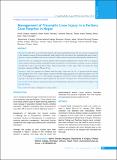Please use this identifier to cite or link to this item:
https://hdl.handle.net/20.500.14356/1363| Title: | Management of Traumatic Liver Injury in a Tertiary Care Hospital in Nepal |
| Authors: | Neupane, Harish Chandra Tamrakar, Kishor Kumar Bhattrai, Abhishek Tamang, Tseten Yonjen Bista, Bishnu Chaulagain, Rajib |
| Citation: | NeupaneH. C., TamrakarK. K., BhattraiA., TamangT. Y., BistaB., & ChaulagainR. (2020). Management of Traumatic Liver Injury in a Tertiary Care Hospital in Nepal. Journal of Nepal Health Research Council, 17(4), 537-542. https://doi.org/10.33314/jnhrc.v17i4.1958 |
| Issue Date: | 2019 |
| Publisher: | Nepal Health Research Council |
| Article Type: | Original Article |
| Keywords: | Liver injury Management Scoring Trauma |
| Series/Report no.: | Oct-Dec, 2019;1958 |
| Abstract: | Abstract Background: The liver is most frequently injured solid organ in abdominal trauma. The non-operative management is the standard treatment for hemodynamically stable patients. This study analyse the epidemiological aspects, injury patterns, treatment modalities and outcome in patients with liver injuries only and associated injuries outside the liver. Methods: This was a retrospective study in patients with liver injuries admitted from 1st March 2014 to 31st January 2019 at Chitwan Medical College and Hospital, Nepal. The patients were divided into two groups. Group A consisted of isolated liver injury and Group B liver injury with associated injury of other organs. Data were analysed by using descriptive statistics and Mann-Whitney U test. Results: A total of 61 patients were admitted with liver injury. There were 18 (29.5 %) patients with liver injury alone (group A) and 43 (70.5 %)liver injury associated with other organs (group B). Low grade liver injuries were 48 (78.7 %) and high grade 13 (21.3 %). The operative management was done for one liver injury with biliary peritonitis in group A. In group B, 16 patients required laparotomy and operative management for associated abdomen injuries. Conclusions: Non-operative treatment modality in hemodynamically stable patients with isolated liver injuries was safe and effective. Keywords: Liver injury; management; scoring; trauma. |
| Description: | Original Article |
| URI: | http://103.69.126.140:8080/handle/20.500.14356/1363 |
| ISSN: | Print ISSN: 1727-5482; Online ISSN: 1999-6217 |
| Appears in Collections: | Vol. 17 No. 4 Issue 45 Oct-Dec 2019 |
Files in This Item:
| File | Description | Size | Format | |
|---|---|---|---|---|
| 1958-Manuscript-13243-1-10-20200121.pdf | Fulltext Download | 1.12 MB | Adobe PDF |  View/Open |
Items in DSpace are protected by copyright, with all rights reserved, unless otherwise indicated.
